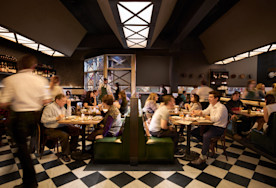Businesses are reopening, and customer demand is fluctuating.
A recent survey from CFIB found that 64% of small businesses are fully open, but only 28% are experiencing normal sales. Businesses that are fully open reported “fewer customers” was the number one reason they were experiencing less than usual revenues. It’s important to be prepared and take advantage of increased customer demand as you reopen. These operational tips will help you prevent customers from lingering at your business.
Streamline your store operations
Tightening up your store operations will help you control exactly when and where customers buy from you.
Offer more than one way for customers to buy
Reduce the odds that you get overwhelmed by experimenting with different ways of selling.
| Where you can sell your item or service | How customers can receive their item or service |
|---|---|
| Online store | In-store pickup |
| Social media accounts | Curbside pickup |
| In store | Shipping |
| Curbside (or outside) | Delivery |
| Over the phone | Virtual experience |
Make sure you can take payments wherever you sell. If you want customers to order directly on Instagram or over text message, you could set up a quick online checkout link. Or if you want customers to call in orders, you’ll need to know how to accept credit card payments over the phone or have the right tools to invoice remotely.
Make it easy to buy in advance
Plan ahead by allowing customers to order in advance from your online store or by booking an appointment to redeem a service or visit at a later date.
Let’s say you sell pottery kits three days a week. Tell customers when they can pre-order kits on those days, and be clear when they’ll be able to pick up or have their items delivered. This can help take some of the pressure off of managing inventory, since you’ll know exactly what’s needed to fulfill those orders. It can also give you more time to order inventory, which is crucial if your industry is dealing with supply chain issues.
Another benefit of having more lead time is that it will allow you to set consistent employee schedules, since you’ll have a better idea of when you’ll need help. It can also help your bottom line. An experiment at Gap retail stores found that stores with more stable schedules also saw a 7% rise in sales.
Create separate areas for each way you sell
Your goal? To separate people as much as possible. To do that, you want to group people according to their needs.
For instance, you can move people through a pickup-only line much quicker since you’re focusing on one job instead of jumping between tasks. If you have a boutique, you could set up a quick browsing section where item names and prices are clearly visible. This will let customers safely see what you have in stock and prevent this group from slowing down others.
Marking off a one-way route through each of these areas will also help minimize contact and speed things up.
Take advantage of extra space
If you have access to a parking lot, sidewalk, or parklet, you may want to use it. See if you need any special permits or permissions from local businesses before claiming it.
Once you know how you can use the space, define the moments when you could really use more room.
- Lines: To help customers safely line up in a designated, spaced-out area.
- Curbside pickup: For customers to park and receive pickup orders.
- Browsing: To help customers safely browse, whether through your store window, a special area of your store, or on an outside table.
- Spillover: You may want extra space when things get busy so customers can spread out without getting cramped in one spot.
Next, figure out the setup you need to be able to use that location. You may have to purchase extra tables, signage, traffic cones, or other supplies to let customers know where they should be.
Streamline your team operations
Your customers’ first interaction is likely with your staff, so you want to help your team feel confident about the changes you’re rolling out.
Staff up for critical store moments and purchase points
Where do customers interact with your employees? Think about where you need people stationed, and then staff appropriately.
Possible interactions:
- Checkout counter or other points of purchase
- Entrance, monitoring capacity
- Curbside pickup, running orders out
- On the floor, helping answer customer questions
- Fulfilling orders in the back
Talk to your team about the tradeoffs they’ll have to make to get people out quickly. You may want to prioritize checking out a customer over inviting someone to enter your store, since it means that person can reduce the time spent inside your business.
List out which tasks are higher priority so your team knows exactly what to do.
Train your team to operate at full capacity
When things get busy, you don’t want your team scrambling. Define what full capacity means for your business, following all province and territory guidleines.
Then, train your team for what those different jobs entail, so they can move around if schedules change or if things get busy. Discuss the issues they may deal with if things don’t go according to plan. What happens if customers can’t find a parking spot out front? Or if the order is wrong? List out worst-case scenarios, and then create a plan for how you’d want your team to respond.
You might also want to have a dry run before you reopen, or even a soft opening with limited hours. This can help you troubleshoot any issues, and devise plans for things you may not have considered.

